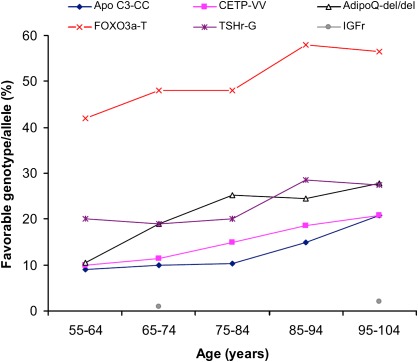FIG. 2.
The frequency and trends of favorable longevity genotypes with aging. These data were obtained in ∼700 unrelated subjects from the longevity genes project at Albert Einstein College of Medicine, of which ∼350 were over the age of 95 years. Because in the U.S. approximately half of the population die by the time they reach age ∼80 years, subjects are selected for exceptional longevity. A polymorphism for longevity will be rather rare in individuals ∼60 years old but will be monotonically increased and overrepresented in centenarians. AdipoQ-del/del, homozygous deletion in the 3′-untranslated region adiponectin gene; Apo C3-CC, apolipoprotein C-3 genotype; CETP-VV, homozygosity genotype in CETP; FOXO3a-T, polymorphisms in the FOXO3A gene; IGFr, polymorphisms in the IGF-1 receptor gene; TSHr-G, polymorphisms in the TSH receptor gene (see text for references). Adapted from Barzilai et al. (74).

